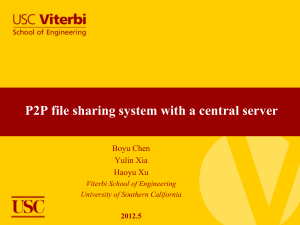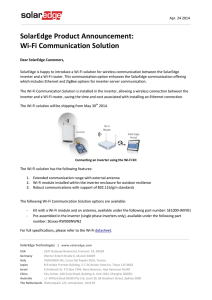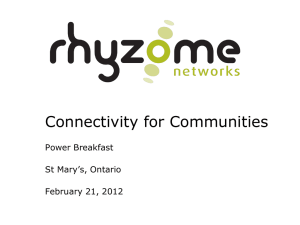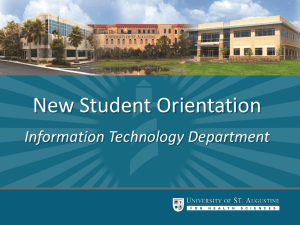RT-WiFi: Real-Time High-Speed Communication Protocol for
advertisement
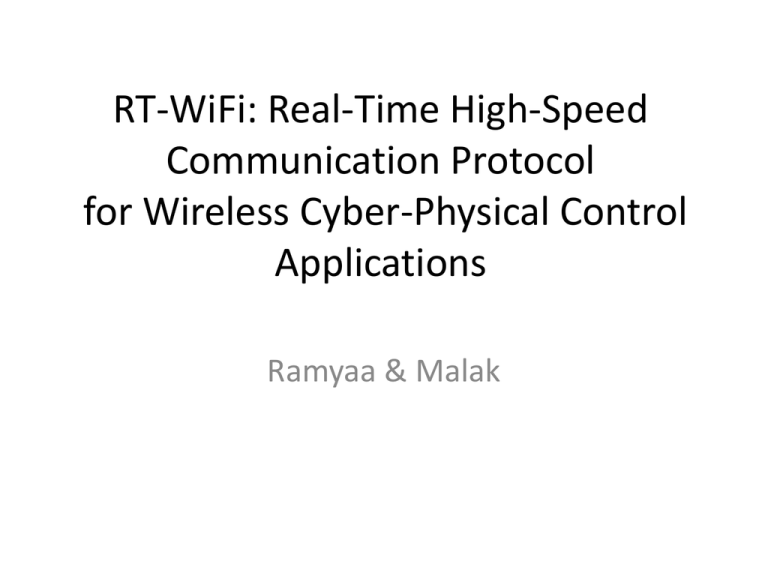
RT-WiFi: Real-Time High-Speed Communication Protocol for Wireless Cyber-Physical Control Applications Ramyaa & Malak Control System • Enhance the mobility. • Reduced the cost of maintenance and deployment. WirelessHART ISA100.11a MBStar Bluetooth ZigBee WiFi Not suitable for high-speed real-time wireless control. Cannot provide high enough sampling rate. Can provide real-time communication, but the maximum supported sampling frequency is only 100Hz Not suitable for high-speed real-time wireless control. Can provide real-time communication, but the maximum supported sampling frequency is only 100Hz Not suitable for high-speed real-time wireless control. Cannot provide high enough sampling rate It can support up to 400Hz sampling rate, which is still much lower than the requirement in many high-speed control applications. Not suitable for high-speed real-wireless control. Cannot guarantee real-time data delivery, except for voice time packets Not suitable for high-speed real-time wireless control. Cannot provide high enough sampling rate Can provide real-time data delivery in beacon-enabled mode, but the data rate is up to 250kbps. High-speed wireless local area network and support data rates up to 150Mbps. In DCF the delivery time of data is not deterministic In PCF cannot provide real-time data delivery guarantee & it is nondeterministic when the subsequent packets will be sent. - Complicate the design - Increase development time & maintenance cost RT-WiFi - Goals Real-time Data Delivery and High Sampling Rate • Requires sampling rate >1KHz IEEE802.11 physical layer. • Time deterministic TDMA mechanism. Flexible Data Link Layer Configuration • Design trade-offs: sampling rate, communication reliability, realtime data delivery, and co-existence with regular WiFi networks. Transparent System Design • Reuse hardware & software available & run existing applications with minimum modifications. RT-WIFI Design and Implementation Performance Evaluation Case Study Conclusion Future Work Control System based on RT-WiFi RT-WiFi Design A. Timer • Global synchronization. • Achieves high sampling rate. • Deterministic timing behavior Node access the channel in its pre-assigned time slots. • Based on (Timing Synchronization Function) TSF. RT-WiFi Design B. Link Scheduler Link • Defines the communication behavior Superframe • Sequence of consecutive time slots Device Profile • Each node has a profile that used by the manger RT-WiFi C. Flexible Data Link Layer Design Out-of-slot retrysize and data rate Co-existence Packet Sampling Rate Reliability with regular WiPacket fails be transmission transmitted intime oneof time slot, RT-is larger Iftothe the packet Fi network: WiFi node can retransmit. than the time slot size then RT-WiFi cannot Requirement of retransmit depends the transmit the on packet. Performing Carrier Sense successfully Packet size Performing application. IEEEIn-slot 802.11 Uses multiple transmission rates retry and data rate Carrier Sense that utilize different modulation and coding Absence of WiFi RT-WiFi node does not perform carrier sense. In-slot retry scheme. Computational resource Higher transmission rate Shortening higher throughput Presence of WiFi Possibility that the two types Synchronization accuracy Out-of-slot Computational less resilient to noise. Inter-frame of traffic could collide. resource retry rate reduce the time slot Higher sampling Flexible data link layer designSpacing Selection of Solution: RT-WiFi nodes perform clear The minimum slot size is influenced by the size. the date rate that best fits the current channel channel assessment (CCA) at theInter-frame start of the Shortening Spacing synchronization accuracy the size of time slot Task Execution in the shorter time interval condition and the desired time slot size. transmission. has to computational be larger than the guard. Interval. Synchronization more resource Interval defined between the transmission accuracy Solution : reduce the guard interval sizeofbytwo utilizing consecutive Wi-Fi packets. more accurate clock. Higher priority for RT-WiFi shorter IFS. D. Association Process RT-WiFi node has no information about TDMA schedule before it joins the network. It works like a regular Wi-Fi node and follows same authentication and association process. RT-WiFi node waits for the next beacon frame. Operates according to the TDMA schedule. Schedule information is attached to the beacon frame in the vendor specific field. Thus, a regular Wi-Fi station can easily associate with a RTWiFi AP without any modification. Platform Hardware Platform Port to any IEEE 802.11 compatible hardware. Atheros AR9285 Wi-Fi chip. Ubuntu 12.04 as the operating system, which runs Linux kernel 3.2.0. Software Platform Two software modules from compat-wireless driver, mac80211 and ath9k are incorporated with the TDMA design to build the MAC layer of RT-WiFi. RT-WIFI Design and Implementation Performance Evaluation Case Study Conclusion Future Work Performance Evaluation Testbed Setting Performance comparison between RT-WiFi and regular Wi-Fi. • Interference free environment • office environment Compare the MAC layer to MAC layer performance between RT-WiFi and regular Wi-Fi in two test scenarios. UDP socket program is installed on each Device. Sensor data with a fixed size payload are transmitted from each station to the AP. AP transmits control data with the same packet size back to each station. Performance Evaluation Latency and packet loss ratio comparison in an interference-free environment The data link layer transmission latency is calculated as the difference of a frame’s TSF timestamps between the receiver side and the sender side. The packet loss ratio measures the percentage of packets lost by tracking the sequence number of each packet. Standard deviation of the latency in RT-WiFi network is less than 5.3µs. Regular Wi-Fi network has a higher average delay and a larger transmission variation. Performance Evaluation Latency comparison between Wi-Fi and RT-WiFi in an interference-free environment Performance Evaluation Latency and packet loss ratio comparison in an office environment Deployed the testbed on the 5th floor of the building. 10 Wi-Fi Aps Latency of regular Wi-Fi network is increased because the office environment has more inference from existing Wi-Fi networks. The maximum latency of RT-WiFi is increased up to 4.2ms. • Uncontrolled mobile devices in the office environment. The packet loss ratio of RT-WiFi network increases to 10%. • Collision with background traffic. Regular wifi - maximum delay – 100ms, standard deviation – 2800µs. Performance Evaluation Latency comparison between Wi-Fi and RT-WiFi in an office environment Performance Evaluation Flexible Channel Access Controller Testbed setting: Network A: – Regular WiFi network – 10 Mbps UDP traffic generator. Network B: – UDP program. configured Network-B by using four settings: • Regular WiFi • RT-WiFi baseline • RT-WiFi with co-existence enabled • RT-WiFi with co-existence enabled and one in-slot retransmission enabled Performance Evaluation Flexible Channel Access Controller Mean delay of regular Wi-Fi is increased to 580µs. • Interference from Network-A. The packet loss ratio of baseline RT-WiFi network is increased to 50.21% • Interference from Network-A. RT-WiFi network in the co-existence mode, the packet loss ratio is decreased to 10.92%. • Enable the carrier sense mechanism • Totally not eliminated because of hidden terminal problem. Packet loss ratio is further decreased to 4.96% when we enable the in-slotretry. RT-WIFI Design Implementation Performance Evaluation Case Study Conclusion Future Work Case study Mobile gait rehabilitation system • Smart shoes with embedded air pressure Sensors. • Multiple IMU motion Sensors a robotic device. • Host computer running control applications. Two types of wireless Links. • Transmit sensing signals from sensing devices to the control applications. • Controlling the robotic assistive device. Case study Integration of smart shoes with a RT-WiFi station Mobile gait rehabilitation system periodically requests sensing signals from air pressure sensors for abnormal gait detection. The real-time sensor data were first collected from an analog-input module NI 9221 on an NI 9116 and then sent through a UDP socket from an Ethernet port of the NI 9022. The RT-WiFi station then forward the sensor data through the RT-WiFi wireless communication link to the RT-WiFi AP on which the controller was running. Case study Emulation of a Wireless Control System: Numerous emulations based on the data traces collected from the smart shoes hardware. Step 1: Data from the smart shoes to acquire the network dynamics (latency and packet loss ratio). Step 2: Emulation to evaluate the performance of the wireless control system. Probability to achieve small tracking errors is always higher for RT-WiFi than regular Wi-Fi. RT-WIFI Design Implementation Performance Evaluation Case Study Conclusion Future Work Conclusion RT-WiFi supports real-time high-speed wireless control systems. High sampling rate. Timing guarantee on packet delivery. Configurable components: sampling rate, real-time performance, communication reliability. It is compatibility to existing Wi-Fi networks. Future Work Fault tolerance. Dynamic resource management. Energy-efficient power management. Extend the network topology to mesh structure. Thank you Why TDMA NOT CSMA/CA ? • CSMA/CA helps to increase throughput, but not support real time traffic. • Wi-Fi packet with a hard deadline may be blocked for a nondeterministic time interval because of carrier sense OR delayed by the random backoff access. • TDMA access the channels according to a strict time schedule. One node can access a certain channel in a given time slot. Types of Link broadcast link Used for transmit a data frame to all the neighbor nodes transmit link used for dedicated data frame transmission to the given destination receive link used for receiving a data frame from the given source shared link is for multiple nodes to compete for transmitting data frames Packet size & data rate • IEEE802.11 allows to use multible transmission rates at phusical layerRT-WiFi can deal with different modulation and coding schemes. • Higher transmission rate provides higher throughput & less resilient to noise and easy prone to error. • Our flexible data link layer design allows the selection of the date rate that best fits the current channel condition and the desired time slot size. Computational resource • Increasing the sampling rate of the TDMA data link layerreduce the time slot size. • For executing tasks in a shorter time interval, more computational resource is required. • The maximum sampling rate supported by a RT-WiFi node is limited by its computation capability. Synchronization accuracy • The guard interval is reserved for the drift between two RT-WiFi devices. • The minimum slot size is influenced by the synchronization accuracy because the size of time slot has to be larger than the guard interval. • We can reduce the guard interval size by utilizing more accurate clock or decreasing the synchronization interval. Reliability • RT-WiFi applies two retransmission mechanisms to improve the reliability of a communication link. • Used either independently or in combination. • Depends on the available computation resource and specific control applications choose the mechanism. In-slot retry • If the sender does not receive an ACK immediately message from the receiver The retransmission is invoked • The retransmission time of an in-slot retry should not exceed the length of a time slot. Out-of-slot retry • If a packet fails to be transmitted in one time slot, RT-WiFi node can retransmit it on the next available link. • Notice that the retransmission heavily depends on the desired application behavior. • For example, on the next available link, if new control/sensor data is available, then it does not make sense to retransmit the old data. Co-existence with regular Wi-Fi network • Performing Carrier Sense: • RT-WiFi node does not perform carrier sense, because the manager will make sure that there is no temporal or spatial reuse in the operation environment on the channel specified in that time slot. • co-existence performance between RT-WiFi and regular Wi-Fi could be poor, because of the high possibility that the two types of traffic could collide with each other. • Solution: RT-WiFi nodes should perform clear channel assessment (CCA). Co-existence with regular Wi-Fi network • Shortening Inter-frame Spacing (IFS): • IFS: interval between the transmission of two consecutive Wi-Fi packets. • Wi-Fi nodes wait for a pre-defined IFS before start to transmit the next frame. • higher priority for the RT-WiFi node a shorter IFS can be assigned for the RT-WiFi node.

